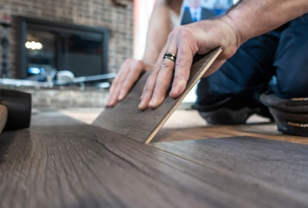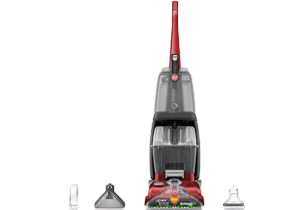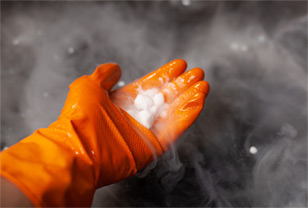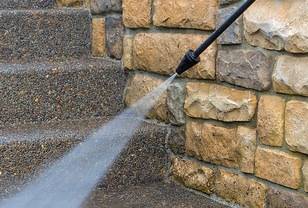How Long Does a Carpet Last - A Complete Carpet Maintenance Guide
But how long does a carpet last? There are not any straightforward answers to this question, as a carpet’s lifespan depends on a few factors: carpet materials, living environment, how often you vacuum your floor, and the number of people residing in the house.
Halls and stairs usually wear out quicker because these are high-traffic areas in most homes. By the same token, a carpet in a spare room that is rarely used will undoubtedly last much longer than those in living rooms.
An average carpet is estimated to last between 5 to 7 years. However, if you have children or a few canines or felines in the house, this number can be lower. Pets can tear up a carpet with their claws, and toddlers leave stains quite regularly.
This article will provide you with a complete guide on how long do carpets last and when to replace them. I will also include a few tips on how to install carpets. So read on as I explore more.
➜ RELATED: Best Vacuum for Long Hair Reviews - The Complete Guide
I. How long does carpet last?
As briefly mentioned above, several factors affect the longevity of carpets, and I will go through some of the most important ones in this section.
1. Materials make a difference
The brand and quality of your carpet play a significant role in determining its life. While some brands make carpets that a carpet cleaner can wash, others are made from more delicate materials that can be hand-washed only.
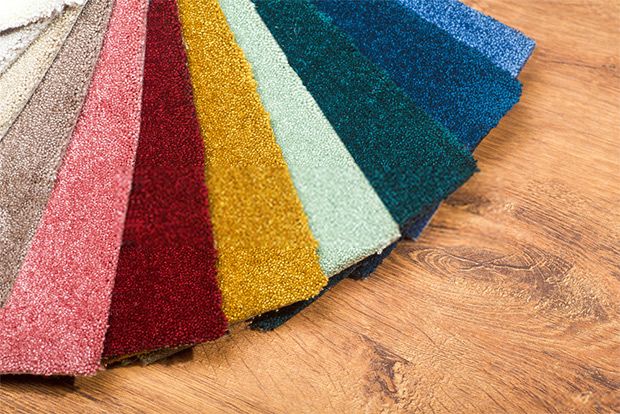
• Nylon
Nylon is soft and durable. It has excellent resistance to stains, wear, mould, mildew, and rot. More than 90% of residential carpets are made from nylon because of their durability and affordability. If taken good care of, this type of carpet can last for 10 to 15 years, making it the go to choice of many homeowners.
• Olefin (Polypropylene)
Olefin or polypropylene is another best-selling carpet material used in both residential settings and commercial buildings. Olefin is usually compared to wool due to its softness. Though it is highly stain-resistant and easy to clean, it quickly collects dirt and dust. When it comes to resilience, olefin is somewhat less resilient than nylon, and therefore it is a bit less expensive than nylon.
• Polyester
Polyester is non-allergenic, and this material is also known for its ability to hold vibrant colours. It's a popular choice in carpet fibre because of its high level of stain resistance and lustrous appearance, which means it has beautiful colours and lasts for a long time. Compared to nylon, polyester is more eco-friendly, as the amount of energy used to produce nylon is much higher than required to create the same quantity of polyester.
• Wool
Wool is a super soft, luxurious, natural and long-lasting material. Pure wool carpet contains no additives or chemicals, making it an excellent choice for allergy sufferers. However, low-grade wool tends to be susceptible to staining, whereas high-grade wool is not budget-friendly. Many manufacturers combine synthetic material with wool to create a blended type of carpet that has the benefits of both materials and is more affordable than pure wool.
• Saxony pile
Saxony pile is a type of short fibre with a lush and fuzzy surface. Saxony is dense and soft, which is why this hi-end carpet fibre is the favourite choice of homeowners with toddlers. However, it is susceptible to stains, wear and tear. Also, since this type of fibre is made up of short strands, it can get crushed down by vacuum cleaners, leaving an unsightly appearance on the surface.
• Cut pile and loop pile
Cut pile refers to the carpet loops that have been cut, whereas the loop pile are carpet fibre with loops that remain intact on the surface. Both come in different thicknesses. However, the cut pile is made by cutting the yarn loops, leaving a more premium look than the loop pile. The loop pile does not show indentations caused by footprints, whereas the cut pile shows footmarks and vacuum trails.
➜ RELATED: The Best Vacuum For Hardwood Floors
Now you are aware of the pros and cons of the six most common types of carpet fibres. Another common question that I constantly come across on many home care forums is ”How long should carpet last?”.
The answer is: there are several factors determining the lifespan of carpet. One of those factors is how you take care of them. I would say nylon, polypropylene, polyester, cut pile and loop pile are all washable by machines. Wool and Saxony pile are more delicate, so they should be hand-washed only to ensure their longevity.
2. Cleaning techniques
How you clean your carpet is determined by what it is made from. A simple tip is to clean it regularly since accumulated dust or grime is usually more challenging to get rid of. Given this, it is best to research whether your type of carpet can be machine washed or not.
Premium carpets are made from delicate fibres, and they easily lose softness and shape. So if your carpet is prone to damage, stick to gentle cleaning methods and liquids only. Also, no matter what cleaning substances you use, make sure that it is thoroughly rinsed out. Otherwise, a carpet can easily grow mould or become rough and affect its aesthetic appeal.
If you have fully carpeted rooms that can't be removed for cleaning purposes, I recommend you vacuum them regularly to pick up dirt and debris. Also, make sure that you know how to pick the best canister vacuum cleaner for carpets like the Miele Complete C3 or the Shark Navigator Lift-away NV352. If you have pets, the Dyson Cinetic Big Ball Animal canister vacuum is also a great choice.
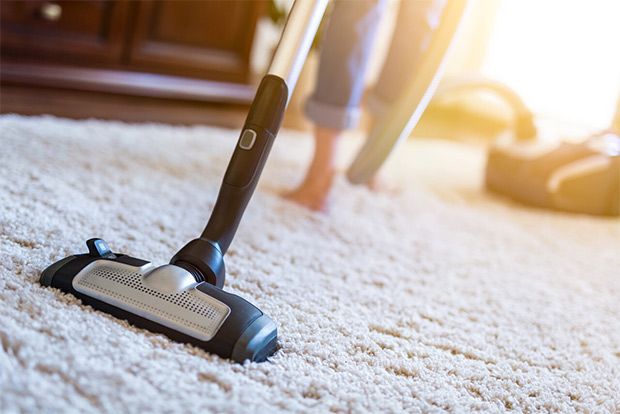
3. Placement
Where your carpet is placed will determine how frequently you need to clean it. Carpets in high traffic areas in your home are more susceptible to stains. Bedrooms and living rooms are prone to all sorts of spills, from kids' paint to food and drink spills. The more you need to wash or clean carpet in these areas, the shorter their lifespan.
The entryway carpet is more exposed to dirt, and if you have pets, you can even find yourself cleaning muddy paw prints, especially during rainy seasons. So it would be a reasonable decision to choose a durable and washable carpet for these parts of your house.
Heavy furniture with pointed legs like cabinets, sofa or tables can permanently dent your carpet and leave the imprint when you need to move them around. I use coasters to avoid damaging my carpet's shape, and if done correctly, you can also add a design statement to your house with these coasters.
If you also have a carpet near a water source like I do, it shouldn’t be left wet for more than several days. Otherwise, it will grow mould quickly and could cause wear and tear before you will even notice something wrong.
I believe by now you know that there is not one quick and easy answer to the question “How long do carpets last?”. The durability of your carpet depends on its build and how you use and maintain it.
➜ RELATED: 14 Best Lightweight Vacuums That Won't Tire You Out
II. When to replace carpet?
How often a carpet should be replaced will largely depend on the type of carpet fibre and the wear and tear it is exposed to. Most carpets last for about 5 to 7 years, which means you probably need to replace them within five years or earlier after purchasing them.
However, parents and pet owners tend to see increased carpet wear than homeowners with quieter lifestyles. There are several factors to consider, as I briefly mentioned in the above section. While there is no definite way to determine when you need to replace your carpet, there are some physical indicators to help you decide when it is the time.
1. Stains
Stains cause irreparable damages to your carpet, and they are the most common reasons for a carpet replacement. Toddlers or canines and felines are usually the cause of these stains, but adults make messes, too. While some stains are easy to clean, others are so severe that many people have to move furniture to cover them.
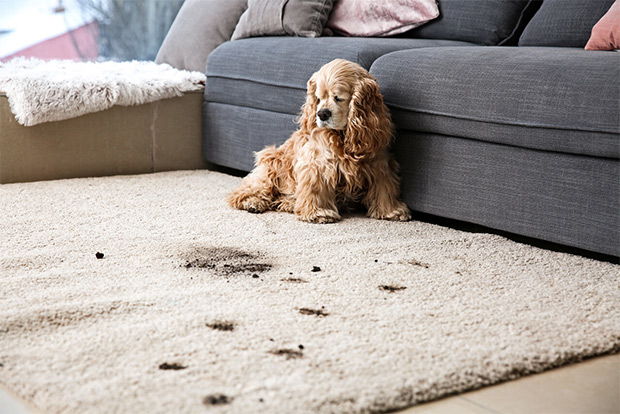
Protein-based stains like baby food, eggs, cream-based foods, and urine are not too difficult to deal with. Cleaning oil-based stains is not really a challenge, either. They are caused by spots from car grease or motor oil, kitchen grease, salad dressing and suntan lotion, which are not too stubborn. I usually mix one tablespoon of liquid dishwashing detergent with two cups of water and clean them with a clean white cloth.
Tannin and dye stains are what gave me a headache the most as they stick. They include spots from red wine, coffee, tea, juice, cherries and jellies. I used to struggle with a few stain spots in my living room. They even had an unpleasant odour that lasted for months. When I tried local professional cleaning services, they could only dull the stains, not remove them. Finally, I had no choice but to replace them.
➜ RELATED: Hoover Powerdash Pet FH50700: Your Ultimate Cleaning Companion
2. Worn-out padding
Padding reduces noise and provides a soft cushion for your carpet, making it comfortable to walk and sit. The pad also protects your carpeting, keeping the underside of your carpet from damaging against the bare floor. If you have lots of furniture, padding helps to minimize the impact of these heavy items and foot traffic on your carpet.
Regular wear and tear will gradually reduce the performance of the carpet padding. The pad can get dirty and flattened, and when it does, it ruins the carpet. Also, just like the carpet, the more it is exposed to wear and tear, the lower its lifespan. When you notice unevenness or wrinkles, it is clear that it's time for a replacement.
3. Smell
Stains, allergens, pet accidents, mould, dirt and dust can all cause unpleasant smells in your carpet. The older your carpet is, the more obvious its smell is. If your carpet still carries a lingering unpleasant odour even after several deep cleans, these persistent foul odours are usually caused by mould or mildew.
It’s very likely that odour has probably penetrated deep into the fibre, the pad, or even the subfloor. If this is what you experience, it would be best to replace the entire carpet to eliminate the odours — trying to salvage it would just be a waste of your time, energy, and money.
4. Patches or matting
High-traffic areas of your carpet can see a lot of use over the years. If you have kids who love to play on the floor or pets that usually turn the living room into their playpen, your carpet quickly becomes thin or can cause matting. When you notice that the pile begins to stay matted down in the most frequently trafficked areas like entryways, stairs or living room, it’s time for a replacement.
Carpets made of polyester fibre tend to be prone to matting, and once the pile starts to lay down because of heavy foot traffic, there is not a lot you can do to restore it. Using professional cleaning services may not do that much to renew its look. You’ll need to replace it pretty soon!
➜ RELATED: Hoover Smartwash FH52000: The Ultimate Solution for Carpet Cleaning
5. Wear and tear
Heavily trafficked carpet areas like the living room, entryways, hallways, stairways tend to show their wear by the appearance of tears, damaged areas or wrinkles. Vibrant colour carpets tend to look dirty when they're worn out. If you can't bring back the original colour, it's probably time for a new carpet.
Replacing carpet can be costly, so I would look carefully into wear and tear signs before investing in a new carpet. For example, fading carpet seems to be a sign for a replacement. However, sometimes dull-looking carpet is still in good condition, only its colour has faded over time. Given this, it's best to look into the fading issue along with another clearer sign of wear before making the decision.
6. Allergies and respiratory issues
If you or your family members keep suffering from sneezing, coughing or a stuffy nose (but not because you're having a cold or flu) it could be caused by mould, mildew, pet dander, allergens or ground-in dirt in your carpet.
Regular inspection can help to prevent mould issues. So you can look for green, black or white stains that gradually grow and then change their shape. These are the early signs of mould building up in your carpet.
The allergens in an old carpet can reduce the indoor air quality, making it unsafe to breathe and increase the risk of asthma attacks. If you notice symptoms like nasal congestion, sneezing, itchy eyes, it would be a good idea to check how long the current carpet has been in your home. It's probably time to replace them rather than going to see the doctor because of these symptoms.
7. Skin irritation and infection
A dirty carpet can cause redness, itchiness, swelling or infection to your skin. Even if you keep to a regular cleaning schedule, dust mites can still evade the space of most diligent home cleaners.

Pet germs can be hazardous for small children as they come in frequent contact with the unclean carpet. Regular cleaning of the carpet can keep fleas and ticks away, but these pests usually can't be eliminated by cleaning alone.
If only chemical treatments need to be used to get rid of these unwanted visitors, then it's best to consider replacing the carpet to free them from your home.
➜ RELATED: Hoover Power Scrub Deluxe Carpet Washer FH50150: A Solid Basic Carpet Cleaner for Small Cleanup Jobs
III. How to install carpet?
Most of us do not usually think of carpet installation as a DIY project because carpeting is often sold with included installation costs. But installing carpet does not have to be tough. Anybody can learn how to install carpet on their own, and installing carpet can be fun.
Once you've got suitable carpet materials to go with, check to see if you've got these tools and materials:
- Tape measure
- Utility knife
- Carpenter square
- Tack strip
- Seam tape
- Knee knicker
- Carpet binder bar
- Power carpet stretcher
- Staple gun
- Wall carpet trimmer
Now let’s get to the cleanup and preparation. The better you're prepared to install the new carpet, the easier and faster the floor covering installation would be. Here are two steps I would recommend you to do before installing the carpet:
- Before removing the carpet, it's best to do a deep vacuuming to protect yourself from dust.
- Start in the corner by grabbing the carpet with pliers and pulling. Now, don't just grab it by hand, remember to wear gloves to protect your hands and knuckles.
- Grab the carpet and pull it up along the entire wall. You can fold back about 3 feet of carpet and cut it into smaller strips for easier handling.
- For the stairs, start removing its carpet from the top by cutting the carpet near the top riser, then pull the carpet off the stairs by hand. If the piece is too long, slide it off into shorter pieces as you go so that pulling is easier.
- Sweep and vacuum the underfloor thoroughly, make sure that it is free of dirt, dust and any residue. This step is to make sure that the surface that will be carpeted is clean and smooth. If there is any paint, scrape it up carefully. Also, the subfloor should be level and have no cracks or dips.
Everything is now ready for installation. Let's get started:
1. Install the Carpet Tack Strips
- First, cover the wood floor with the carpet padding, then use a stapler to tack down the padding.
- Second, you can use a hammer to nail down the tack strips around the perimeter of your room. Next, use a small hand saw to cut a strip 1 inch wide. Now you will need to set the tack strip about half an inch away from the baseboard, providing space for slipping the carpet underneath.
Note that if you’re installing high-pile or wool carpets, it would be better to install two rows of tack strips to prevent the carpet from shifting out of its position.
2. Stretch the carpet
- If your carpet has a particular pattern or texture, make sure it's unrolled in the correct orientation onto the room's padding. Now, use a knee knicker to install the carpet into the position against the wall and keep moving along. Make sure you pull out all wrinkles by striking the kicker with your knee.
- Pull the carpet tight to the wall by pressing it firmly onto the tack strips. If there are oversized carpet pieces, make sure they lap over each wall by several inches.
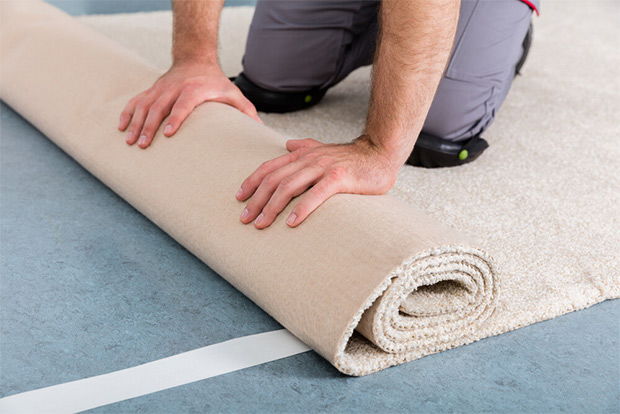
3. Trim the edges
- Use the utility knife or carpet-edging tool to trim the carpet flush, keep the carpeting tight against the baseboard, and pull away from the excess carpet strips.
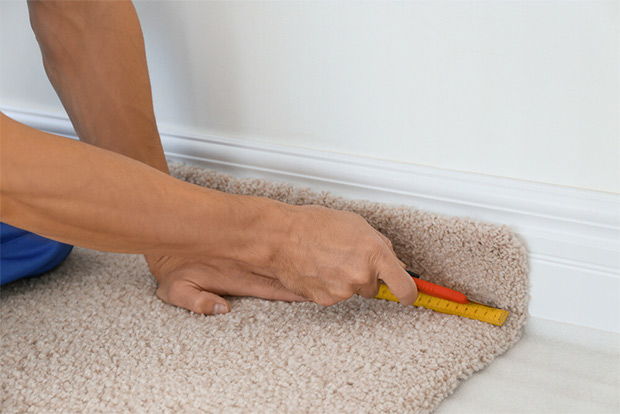
4. Push the edges under the baseboards
- Force the edge of the carpet beneath the baseboard moulding. This step should be done slowly and carefully not to scratch the moulding.
- Now you have carpet installed to the tack strips along one wall, move on to the opposite wall and repeat these steps. Once the carpet is secured along two walls, you only need to repeat the procedure to attach and trim the carpet along the borders.
➜ RELATED: Bissell 3624 Spot Clean Pro - An Excellent Portable Vacuum Cleaner for Carpet Spots and Stains
5. Seam up the adjoining pieces
If you need to seam together two or more carpet pieces, use the seam tape to join them together.
- Using the electric seaming iron, seam the edges of two pieces of carpet together, but make sure that they do not overlap.
- Run the tape along the entire seam and make sure it’s tightly positioned halfway under the carpet.
- Glide the iron between two carpet pieces, activate the adhesive on the seam tape, and press it down firmly on the carpet.
6. Install the carpet stairs
Installing carpet on stairs can be done in two ways:
- First way: run the carpet down the riser, wrap it tightly around the front edge, then tack the carpeting to the treads' underside.
- Second way: flow it from one stair to another, then tack the carpet down along the tread's rear edge. You will not need to tuck the carpet under each nosing of the tread.
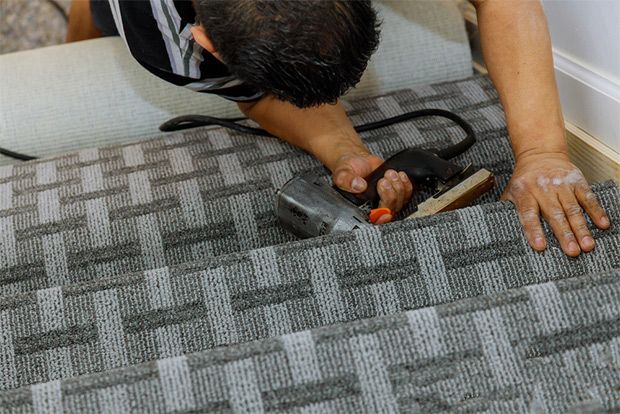
7. Finish the edges
Use a binding tool to produce a clean and finished look for the edges of the carpet. There are lots of portable carpet binders sold online, so finding one shouldn’t be a problem.
It's now time to enjoy the new carpet of your home. Replacing carpets is not that hard if you have the right tools and follow these simple steps.
By now, you've probably learned when to replace a carpet and how to install a carpet. One of the most important factors of carpet durability is its build. The better the material, the longer it will last. But how to choose the right carpet style and material without being ripped off? Read on and I will give you a few tips.
IV. Tips to choose carpet
1. Consider the padding
You will not see the padding after the carpet is installed, but that does not mean you should skimp on the padding to save your carpet installation cost. The layer of padding is essential for support and cushioning, and it evens out any imperfections in the subfloor, insulates the floor, and acts as a noise barrier.
Picking the right padding means that there will be less wear and tear on your carpet because padding prevents the fibre in your carpet from coming apart over time. High-traffic areas require firm and dense padding, while light-traffic rooms might need less protection.
➜ RELATED: How To Clean A Carpet - Top 9 Cleaning Carpet Tips
2. Pick the right styles
Your lifestyle will determine the right styles of carpet for your home. How long does a carpet last will also depend on how well you choose the carpet style. There are many styles of carpet: Saxony, plush, Berber, frieze, and textured. These terms refer to the pile on the carpet's surface created from yarn tufts folded into loops.
Aside from thinking about how the carpet looks and fits into your home's overall interior design, consider how it will fit into your lifestyle as well. For example, plush carpet is super soft, but it tends to leave footprints and vacuum marks, so it should not be your choice for high-traffic areas, but you can use it for the family room.
Suppose you have pets and kids, a hard-wearing, a textured loop pile, or a hard-twist cut would be ideal. If you love various styles, a combination of cut and loop pile in contrasting textures can create a modern look for your house. Besides, a blend of light and dark patterns will be less likely to show footprints.
3. Anticipate fading
The carpet will fade over time after installation, so you will notice that it will appear lighter over time. Regardless of your colour choice, it will fade, which is why you might want to choose a carpet colour that is about two shades darker than you planned.
➜ RELATED: How to Get Dog Hair Out of Carpet - How to Get Rid of Dog Hair in House
4. Treat the stairs with extra care
The carpet on your stairs has to be bent over the edges of each step. It will also receive more traffic resulting in a lot of wear, which means a cut-pile carpet works better than a loop-pile.
You might want to consider the density of your carpet stair. One easy tip is to stick your fingers deeply into the sample for testing, and if you can easily separate the fibre and feel or see the backing, it's probably not dense enough for the stairs. Wool carpet is the ideal choice for stairs for its durability, but it is pricey.
➜ RELATED: Carpet Made Easy: How To Remove Carpet?
5. Consider green and recycled materials
Carpet, padding and adhesive can drastically impact our environment and health, especially for those with asthma and allergies. It's best to protect your family by choosing carpet made from natural or organic materials such as non-synthetic latex, untreated wool, camel hair felt, or those without chemical dyes.
You can also choose a carpet made from recycled materials, so look into the percentage of recycled content when buying. Carpet made from renewable fibre tends to be the most environmentally-friendly because manufacturers do not use fertilizer or pesticides to produce them. So check for sisal, seagrass, coir, jute, organic wool, cotton or bamboo.
➜ RELATED: How to Get Urine Smell Out of Carpet: Essential Cleaning Techniques
The conclusion
So, how long does a carpet last? It depends on the carpet material, how you choose the right type and carpet styles for different areas of your house. A carpet’s lifespan also relies on how well you maintain it over the years. Also, if you're keen on a sustainable lifestyle, opt for renewable carpet materials to protect the environment and your family’s health.






